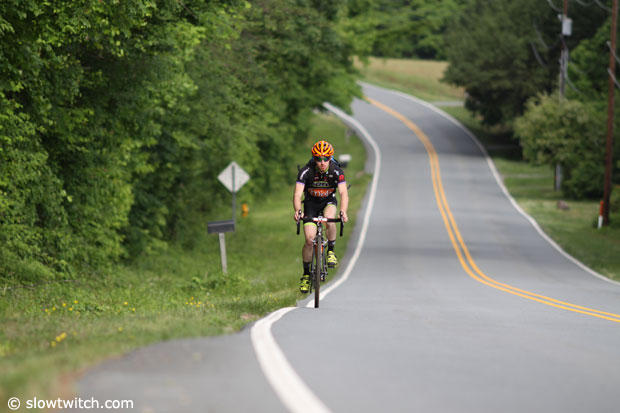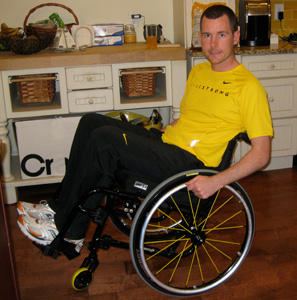CHP talks to Slowtwitch
After several attempts bicycle advocates in California finally succeeded in passing a 3-foot law, that is, a law which obliges a motorist to grant a minimum 3-foot buffer to bicyclists. This law went into effect about 6 weeks ago. What these advocates hoped, but failed, to get from the state legislature was an allowance for motorists to cross the double yellow line when safe in order to grant cyclists their new legal buffer.
It was just a matter of time before this became an issue, and this week it did. "On a two lane road with double yellow line, a SUV passed us, and went over the double yellow," writes a member on the Slowtwitch reader forum. "The CHP [California Highway Patrol] officer wrote her a ticket. [Then the] CHP officer followed us. We pulled over and stopped, and he said he could not legally pass us, due to the width of our lane. He went on to say we could receive a ticket for 'impeding traffic.'"
I reached out to the California Highway Patrol. I interviewed Edgar Figueroa, Public Information Officer for the California Highway Patrol, Southern Division. He is experienced in and is keenly interested in the coexistence of motorists and cyclists. Geographically his area of interest encompasses the Santa Monica Mountains west of Los Angeles, a network of twisty, mountain 2-lane roads that is a haven for road cyclists, as well as motorcycles and cars. I described the situation above, which occurred in a rural part of San Diego County, and asked him a few questions.

Slowtwitch: The California Vehicle Code's most on-point section dealing with cyclist behavior is 21202 and it reads in part, “Any person operating a bicycle upon a roadway at a speed less than the normal speed of traffic moving in the same direction at that time shall ride as close as practicable to the right-hand curb or edge of the roadway.” There are exceptions but, really, that's it. My question is: If a cyclist is riding as far to the right as practicable, in accordance with the law, when is he in danger of falling afoul of the vehicle code by impeding traffic?
Officer Edgar Figueroa: I cannot speak to the officer in San Diego. I can tell you a few things. Our mission is to prevent accidents and injuries. This scenario, what do you do? Educating is the best way to accomplish what we want. As for impeding traffic, if a bicyclist is confronted with this situation because of traffic, weather, vehicles behind, the safest thing is to move to the right, to adjust speed, to not impede traffic. In my opinion as an officer, I worked county roads, my number-1 goal was to prevent traffic collisions happening. A lot of that has to do with the officer's judgment. Part of that is a verbal warning.
We're not just writing tickets. A big part of it is educating. The officer has a duty to stop and talk to that person, even if it's an uncomfortable conversation. Ultimately the goal is to save lives, and to have that moment where we both understand. We want the cyclist to enjoy his ride, and to get home safe.
ST: It seems to me there is a conflict in the vehicle code. Section 21460 explains that, except for left hand turns into driveways, there is no crossing a double yellow on a 2-lane road. However, 21750 says that a motorist must give a cyclist a 3-foot buffer. How does the CHP intend to enforce this?
Officer Edgar Figueroa: The double yellow law was created to prevent accidents, preventing a head on collision. I think what's important is for motorists to know their vehicle, know the dimensions. A typical vehicle is 6.5 feet wide, a typical lane is 11 feet, usually the pass can be made without crossing the double yellow. But on some country roads, with gravel or debris on the right side of the lane, the cyclist must ride a few feet inside the shoulder. I'm not going to stop a vehicle crossing double yellow to give the cyclist enough room, if it's for safety. For bicyclists, motorists are trying to grant 3 feet, when a car is approaching move over slightly if you can.
ST: My sense tells me that the double yellow decision is based on engineered decisions that assume cars passing other cars at high speed, not to pass a bike at low speed. Does this seem relevant?
Officer Edgar Figueroa: Yes, I believe so. Circumstances change, but I believe that our officers are trained and have good judgment. The double yellow law was designed to keep vehicles from crossing completely over the double yellow line. If he's completely over, entirely into the oncoming lane, I'll take enforcement action. But if he's somewhat over the double yellow in order to protect a cyclist, that's different.
Officer Figueroa’s answers showed, to me, not only a helpful attitude toward sections of the California Vehicle Code that live in tension if not in outright conflict, there were some meaty answers in there if you read carefully. The officer parsed between crossing the double yellow with any of your car versus with all of your car. Still, as I contemplated both the tension between the 3-foot law and the double yellow inviolability, I wonder whether the 3-foot law might be viewed as a tool by officers who harbor grudges against cyclists. I asked noted cyclist and cycling attorney Bob Mionske about this in an accompanying interview.




Start the discussion at slowtwitch.northend.network